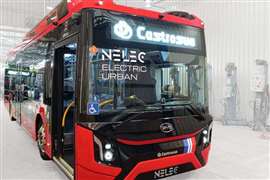Read this article in 中文 Français Deutsch Italiano Português Español
New DOE funding program targets commercial EV charging infrastructure
18 September 2024
According to U.S. Dept. of Energy (DOE) data, there are a little more than 11,000 DC fast charging stations in the United States. While that number may seem impressive, it is nothing compared to the more than 145,000 conventional fueling stations across the country, according to data from the National Association of Convenience Stores (NACS) as reported by the American Petroleum Institute.
To help foster the growth of electric vehicle (EV) charging infrastructure that specifically supports medium- and heavy-duty vehicles, DOE recently announced the SuperTruck Charge funding program. The program’s $72 million is earmarked for projects related to the design and development of charging infrastructure for medium- and heavy-duty electric vehicles near ports, distribution hubs and along major transportation corridors. DOE’s Vehicle Technologies office, which is administering the program, expects to make two or three awards. A DOE spokesperson said this relatively low number is because of the expected complexity and high capital expense of each project.
The announcement of the program, which is being administered by DOE’s Vehicle Technologies Office (VTO), cited several hurdles to be overcome in growing commercial EV fleets with tens to hundreds of thousands of vehicles. These include the need to support long-haul EV use cases, which DOE defines as those traveling in excess of 500 miles per day, as well as addressing charging infrastructure in rural areas and along transportation corridors where grid capacity is limited.
Additionally, the funding program seeks to support global goals of using EVs to decarbonize road transport. In 2022, the United States joined other signatories around the world in the Memorandum of Understanding (MOU) on Zero-Emission Medium- and Heavy-Duty Vehicles (MHDV). The MOU, which was initiated by national nonprofit CALSTART via its Drive to Zero initiative and is co-led by the Netherlands government, seeks to enable 100 percent zero-emission new truck and bus sales by 2040. By 2030, the MOU is driving to a goal of 30 percent of all Class 6-8 vehicle sales be zero-emission.
“Further research, development and demonstration of high-capacity, high-power charging installations with vehicle grid integration (VGI) strategies for electrified MHDVs will be critical to meet these goals,” DOE said, “while ensuring equipment interoperability, mitigation of grid impacts, improving grid resiliency and reliability and creating downward pressure on electricity rates.”
According to DOE, the program is expected to address current gaps in the charging infrastructure for electrified Class 6-8 trucks by encouraging recipients to develop innovative charging solutions for such fleets. The department said it expects this will help accelerate the deployment of other large-scale public EV charging infrastructure while also making the U.S. electric grid more reliable and resilient.
Aside from the aforementioned MOU and the Drive to Zero initiative, heavy-duty trucking is facing forthcoming U.S. Environmental Protection Agency (EPA) greenhouse gas (GHG) emissions regulations set to take effect with the 2027 model year. These new standards are 80 percent more stringent than current rules and are intended to foster ongoing adoption of alternative power sources, including electrification. EVs are posing a challenge for truck makers, however, in part because have far fewer charge points available than necessary for broad adoption, particularly with regard to long-haul trucking.
“There is no charging infrastructure to speak of anywhere in the country,” said Power Progress columnist Jack Roberts in a recent column. “Installing private charging infrastructure is outrageously expensive, as well.”
Roberts also reported that there has been pushback from the heavy-duty trucking industry against the drive to zero-emission trucks. At the Advanced Clean Transportation (ACT) Expo in Las Vegas in May, Shelley Simpson, president of J.B. Hunt Transportation Services, said BE trucks are not a viable option for large fleets at the moment.
“In order to fast-charge a single electric truck, you would need the same amount of energy it takes to power 600 homes,” she said. “To put that into perspective, the fast-charging infrastructure needed to support J.B. Hunt’s entire fleet, if it was all electric, would be the same as that required by 1.4 million households, or about 1% of the U.S. population.”
POWER SOURCING GUIDE
The trusted reference and buyer’s guide for 83 years
The original “desktop search engine,” guiding nearly 10,000 users in more than 90 countries it is the primary reference for specifications and details on all the components that go into engine systems.
Visit Now
STAY CONNECTED




Receive the information you need when you need it through our world-leading magazines, newsletters and daily briefings.
CONNECT WITH THE TEAM














